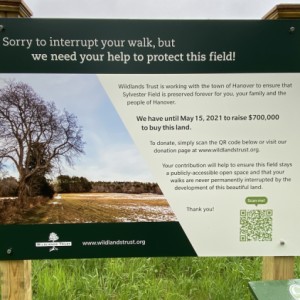Sylvester Field, what old Hanover looked like
Last night, at another late Town Meeting this field was saved with an unanimous vote. Community Preservation Funds, Wildlands Trust funds and contributions will allow the town to purchase the land from the estate of the deceased landowner who gave Hanover first dibs on the sale. We need about $60K from local donations to seal the deal. Sadly the town selectmen were fine with just selling the land to developers!
The lower right photo in the collage is a small painting I did several years ago for a painting exhibit/fundraiser I had at the Historical Society a few years ago. It now belongs to our blipfriend, aprecious and hangs on her wall in Cornwall. Two other blippers, Wall & Kangazu came to the exhibit too while on vacation in Massachusetts!
Some history of Sylvester Field
The field was once part of the land owned by William Barstow (1612-1668), who is believed to be the first European settler in the present bounds of Hanover. Barstow, a surveyor for the Town of Scituate, owned the land between the North River and Broadway and between Third Herring Brook and Washington Street. In 1656, Barstow was contracted to build the first bridge across the North River, which he completed in 1657, enabling more efficient passage between Boston and Plymouth. Barstow also maintained and Ordinary near the bridge and the second oldest shipyard on the North River, "Old Barstow Yard" was located nearby.
This parcel was part of a larger farm that was built by the Stockbridge family in the early 18th century. Benjamin and Martin Stockbridge were forced to sell all of their landholdings in 1815, after which the Sylvester Family took possession of it.
Most of the farm was sold to the Marden's in the 1940's, and development began. Betsey (Sylvester) Robinson purchased the parcel in 1956 to save it from development. The rest of the once open farmland is now Old Bridge Road and Old Shipyard Lane developments.
It was the site of the Red and Blue War of 1909, a "mimic war" with an encampment of over ten thousand participants, including foreign military attaches.
It included the 10111 Cavalry (an African American troop) which served with Col. Roosevelt at San Juan.
It contains an historic stone wall which was built in 1913.
The Sylvester Field's open field habitat is increasingly rare and imperiled across the region. Open field habitats support the life sycles of numerous common wildlife species and many rare species, including Eastern box turtle and several species of ground nesting birds.
For the Record,
This day came in cold and rainy. The Wildlands Trust signage is an extra.
All hands thankful for T's second jab tomorrow.


Comments
Sign in or get an account to comment.


